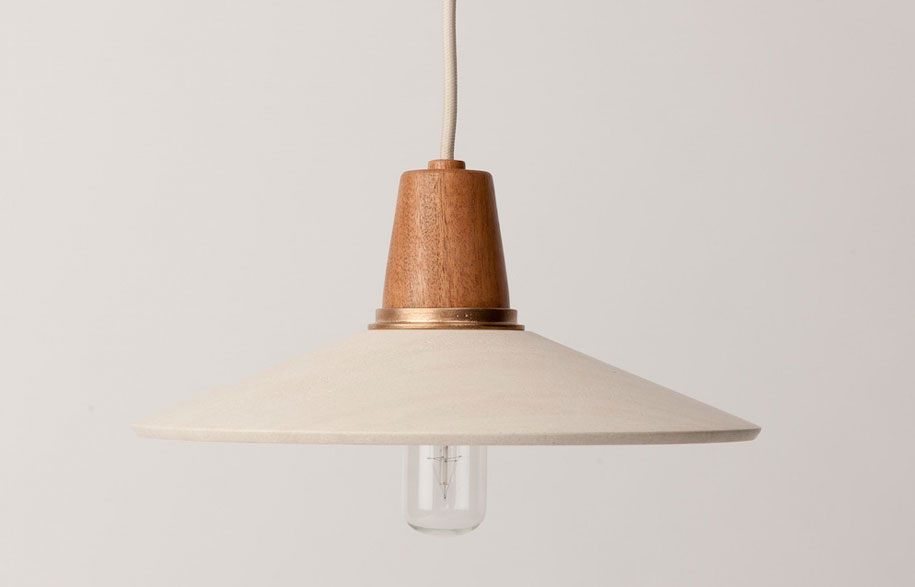
Function is a given when it comes to lighting design; it must facilitate illumination. When it comes to form, however, the only limit is the designer’s imagination and will to experiment. And as Rebecca Gross discovers, the imagination and experiments of these emerging designers is evidence of the high calibre of award-winning talent in Australian lighting design.
HUGH ALTSCHWAGER
Story continues below advertisement
A relationship with the land runs strong in Hugh Altschwager’s blood. He is a sixth generation farming son from South Australia and has Nordic heritage; and both are evident in his lighting designs crafted from Mt Gambier limestone and reclaimed Australian hardwood. Establishing Inkster Maken in 2013, Hugh says a large part of his work is “inspired by naturally occurring materials and the inherent qualities and characteristics that different varieties and species possess.”
Hugh’s lighting, such as the Firefox Pendant and Flashlight Pendant, have a clean and balanced aesthetic and are made from stone and timber for warmth and tactility. “I’m drawn to using under-utilised natural materials,” Hugh says, “and develop self-taught techniques to work with them.” This includes turning limestone on a wood lathe or casting molten bronze into hand-carved limestone moulds, a process he developed for the recent Object Future III exhibition. Indeed, Hugh says, “knowing and understanding the capabilities and limitations of natural materials informs a lot of my designs.” And, he continues, “doing things that haven’t really been done before.”
Hugh Altschwager
inkstermaken.com
Story continues below advertisement
Photographs: Hugh Altschwager, Foxfire Pendant, Flashlight Pendant, Eclipse Wall Light
Story continues below advertisement
LAB DE STU
André Hnatojko, Dale Hardiman & Adam Lynch are the three designers behind Melbourne-based Lab De Stu. Meeting at RMIT University, the trio has been producing lighting individually and in collaboration since 2012, as well as working with other designers and under other affiliated brands, such as Dowel Jones and 1-OK CLUB. While the designers produce lighting quite different to that of their counterparts, “simplicity” is a uniting theme. “This is to aid manufacturing in Australia, while never compromising on quality,” says André.
Taking inspiration from each other, the Lab De Stu collective enables André, Dale and Adam to “share new ideas in a forum that allows new ideas to grow.” In addition, other collaborations and businesses force them to adapt to new environments and scenarios, which, they say, results in a “creative process that is forever changing.” And certainly Lab De Stu is not just where these creative talents come together to push their concepts of design; it is also where their products collide. The colourful Polly Popper is a design created from a 50/50 split between Dale’s Polly light and André’s Popper light and it morphs forms and mixes materials to explore the possibilities of new outcomes.
Lab de Stu
labdestu.com.au
Photographs: Lab De Stu, Polly Popper (André Hnatojko and Dale Hardiman), Dowel Jones (Dale Hardiman and Adam Lynch), Lord Scone (Dale Hardiman and Adam Lynch)
LOZ ABBERTON
Loz Abberton’s company Who Did That is aptly named since her range of lighting is so striking, one could easily ask, “who did that?” Based in a coastal village just south of Hobart, Loz takes inspiration from Australia’s heritage and landscape and nature’s patterns and materials, much like those great proponents of the Arts & Crafts movement. In fact, her design philosophy reads like a modern-day interpretation of the Arts & Crafts ethos as she creates “future-friendly” and “future proof” lighting designs.
Loz uses sustainable resources and certified local materials (such as Chain of Custody certified timbers and kangaroo leather) and experiments with how they perform under external impacts. “This filters from a rural upbringing where items and resources had long lives; being repaired or reused was natural progress,” Loz explains. She takes great pleasure in the process of making and aspires to realise only “beautifully-crafted and timeless designs that are functional and highly durable, and with which people can develop an aesthetic and emotional connection.” The result is a series of pendants, such as the laser-cut and hand-woven Reggie and Pod Luxe, which play with pattern, symmetry and movement to create illumination and illusion.
Loz Abberton
whodidthat.com.au
Photographs: Loz Abberton (Photo: Chris Crerar), Pod Luxe Wide (Photo: Chris Crerar), Black Hoop, Black Cotton
LIAM MUGAVIN
After completing his degree in Industrial Design, Liam Mugavin headed to Japan for four years. In 2013 he returned to Australia to launch his own design practice and undertake a two-year intensive training program at JamFactory in South Australia; but he never left Japan behind. “My lifestyle and way of life definitely follow a Japanese approach,” Liam explains, “ironically I don’t own much furniture and eat sitting on the floor.”
Using an amalgamation of craft and production-based techniques, Liam’s lighting is also inspired by Japanese aesthetics. “My work often features repetition of lines and negative space formed between lines,” he says, which is evident in the Toro Nagashi lighting collaboration with Melbourne-based Rakumba. Influenced by traditional Japanese lanterns, this series of lighting explores and reverses the nature of positive and negative space. Liam combines imagination, conceptual work, experimentation, and prototyping in a design philosophy he describes as “hands-on mindfulness.” The result? Each piece “is an evolution of the previous piece” and “a representation of my own experience rather than that of other people,” Liam says.
Liam Mugavin
liammugavin.com
Photographs: Liam Mugavin, Toro Nagashi for Rakumba, Toro Nagashi for Rakumba, Koto
A version of this story also appears in McGrath Magazine.